The Millennium Knightsbridge Hotel is prestigiously situated in the Royal Borough of Kensington & Chelsea, one of several royal boroughs in England.
Street signs (which are located on the sides of buildings, to avoid the clutter of street sign poles on the pretty streets) indicate which borough you are in.

The hotel is located on Sloane Street, which is named for a globe-traveling Anglo-Irish physician and art collector, Sir Hans Sloane, who bought the land in 1712. His descendants are the Earls of Cadogan...
and they still own most of the properties (thousands of shops, houses, and apartments) and 93 acres.
Begun in the 1000s, (derived from the Scandinavian jarl), the rank of earl is the oldest title in the British peerage, and 191 earls exist today. That earldom has been the area's landlord for 300 years, and it watched the area mature from swamp to eliteness. (The current 8th Earl Cadogan is 84-years-old). Sloane's other legacies include inventing the recipe for chocolate milk and bequeathing his art collection to England—which became the Natural History Museum. Sloane Square, Sloane School, Hans Street, Hans Crescent, and Sloane Gardens are all nearby and dedicated to him.
Similar to the one in Manhattan, the neighborhood of Chelsea has diversity and artistic flair... except it is cleaner and repaired better. Whereas NYC's Chelsea focuses on being a hub of homosexual hedonism, London's is full of shops, restaurants, galleries, and cafes... where you're not ignored if you are clothed. Click here to see NYC's Chelsea:
https://halfwindsorfullthrottle.blogspot.com/2015/12/picture-walking-tour-of-chelsea-nyc.html
*A sliver of Old-World style remains in Manhattan's Chelsea. To glimpse its prettiness, please use this link:
https://halfwindsorfullthrottle.blogspot.com/2017/06/walking-tour-english-village-scenery-in.html
As a world-renown event, the Chelsea Flower Show was postponed from springtime to September, due to the pandemic. That gave us an unexpected treat to enjoy it! 70 local eateries and businesses were decorated with floral exuberance!
Lewis was wide-eyed at this building, seen below! Even the doorman's uniform is flowery. Annabel's is one of the most elegant social clubs in the world, and it always has flamboyant décor on its exterior.
On the topic of site-seeing, tourists can buy London Visitor Cards.
Based on time increments, they include unlimited travel on public transportation and one free admittance to dozens of attractions, such as the Guildhall Art Gallery, Royal Air Force Museum, royal palaces, Shakespeare's Globe Theatre, Botanic Gardens, London Zoo, tours of stadiums, and distillery tours. However, since the city's largest museums are free to everyone, and there is no cost to enter churches or cathedrals, we opted not to get those cards.
Instead, Lewis and went to the Underground station to buy an Oyster Card. It's called an Oyster because the chip-card is encased in the card itself—for security and protection. The £5 fee to buy it is non-refundable, but the cards never expire. So, whenever we visit London again, our cards will still work—and retain any unused balance. That is cool. Tap-and-go technology let us buy our cards quickly, and you tap-to-load the card with monetary value.
Unlike other cities where you can only add value to the cards at transit stations, you can upload funds to your Oyster Card at hundreds of shops that feature the tap-and-go kiosk. That is hugely convenient.
Conveniently, England operates as a nearly cashless society; most transactions are completed with e-payment. Tap-and-go. It's wonderful and easy—whether buying tea or train tickets.
Another surprise was that London's transit system "caps" you after 3 usages in the same zone per day. NYC's system charges you for each usage, but London says, "We have enough of your money, so if you ride a Metro/bus/ferry more than three times per day, we won't take any more money". Also, you pay for the length of your journey. Since the Underground (and Overground) systems are so expansive—into the suburbs—they include 9 zones. However, all of Central London is in Zone 1-2, which is the cheapest fare. But, it's great to know that commuters can take the Metro into their suburbs, instead of needing extra tickets for commuter trains.

Lewis and I witnessed the Metro systems of New York City, Boston, Nagoya, Osaka, Paris, Copenhagen, and Amsterdam. However, London's is the most impressive and well-connected.
Of wonderful importance is how circuitous the routes are. Notice how many loops allow you connect to places across the vast city. It makes it easy to get around. That is how a modern city should be.
It is the opposite of NYC's greedily-unhelpful subway system, which resembles a drainage system designed only to feed Manhattan... and doesn't care about letting people get between boroughs. (I assure you that any crossover you see is NOT connected between subway lines). In overpriced NYC, you must go back the way you came, change trains, and then go out again... if you want to get to another area.
Equally helpful are the directories at each Metro platform that indicate all of the upcoming stops for each direction of the trains.
Unlike NYC's steamy-hot subways, London's are cool—and CLEAN. Fans are strategically located to circulate air in any warm places. This was our eleventh visit to a capital city, and we are convinced that only America uncaringly lets its transit systems deteriorate in squalor. Everywhere else maintains very clean facilities... as it should be.
The overpaid imbeciles who manage NYC's Metropolitan Transit Authority give excuses that they can't keep the tracks dry/clean because the system is so large (with 640 million riders). This is what the MTA is like...
London's system is older (with 1.3 billion riders) but it miraculously stays cleaner than anywhere in NYC, which is America's richest city.
Like a proper rail system, easy-to-read clocks are visible.
It's also easy to exit a train and know which way is the exit (or transfer point to another route).
To our dismay, some trains relied on open windows, instead of using their air-conditioning, so we found them to be too warm. But we were grateful that they were very clean.
Exiting at Covent Garden Station, we used its elevator (something we rarely have at home) to the street.
We "tapped out" to exit through the gates.
We marveled that such a busy Underground station was housed in a quaint historic building, circa 1907. Had it been in NYC, it would've been surrounded by pushy people, beggars, homeless people, graffiti, and litter. In London, plenty of people used it, but it was as picturesque and unhurried as if it were in the Cotswolds. There was never a bottleneck of traffic.
The pedestrian-only area is full of various stores and pubs, and it is cordoned-off from traffic by rustic flower-filled carts.
As I mentioned earlier, the capital of London encompasses (but doesn't govern) the City of London. However, it also encompasses another "City" that it does govern. Amongst its boroughs, it includes the City of Westminster, which contains the national governmental buildings, Chinatown, and many site-seeing attractions. Most visitors spend a lot of time in it. Below is a map of the City of Westminster's borders within London.
Predating the Norman Conquest, the City of Westminster was founded in in the 1050s. King Edward the Confessor chose the site for his government—and to furtively watch the City of London. He also built the precursor to Westminster Abbey, and its abbot grew rich from politics and royal servitude.
Covent Gardens is part of that city. In the 1200s, Westminster Abbey & Convent used it as an orchard. That is how it became known as Covent Garden.
In the 1700s, it was a Red Light District (that is now in SoHo). Nowadays, the open-air market has a sunroof. The Royal Opera House is also located there.
Seen above, the building resembling a Greek temple is St Paul's Church. In 1631, it was commissioned by the fourth Earl of Bedford (who owned the land at that time). As seen in these images, it withstood centuries.
Across from it, enclosed arcades provide sublime shopping.
We had noontime reservations at a Taiwan-based restaurant named Din Tai Fung, and 12pm is when it opens. With care and discipline, it is an extremely well-run franchise that earned a Michelin-star at its Hong Kong location. In 2018, London was chosen for the first location in Europe. We were excited to eat there.
Two orderly queues existed for those with reservations and those without. Exactly as a bell tower chimed 12 o'clock, two reservationists unlocked the front door, set up a podium, and got everyone inside. It was all done smoothly with decorum. Seating 250 people, the bi-level restaurant is famous for its handmade soup dumplings (xiao long bao), which are made in a glass kitchen, so you can watch them knead the dough, create each shape, add the filling, and twist the top. To ensure quality, key ingredients are imported from Taiwan. The service was correct without being stuffy, and our food was superb.
The pan-national waitstaff worked cohesively. The waiter who took our appetizer order was French, but the servers who took our main-course orders were Chinese. They politely noticed Lewis' American accent when he spoke Mandarin to them. (None of the perfectly-poised waiters were from the island-nation of Taiwan, so Lewis didn't get a chance to speak Taiwanese). The food runner was a young Caucasian Englishman.
Reminding us of Japan, the restaurant provided a classy item: a holder for your bags, so they didn't touch the floor.
Such thoughtfulness extended to the cuisine, too.
The technique for getting soup into the dumplings is to use a gelatin of bone broth, which melts as the dumplings are steamed. The recipe originated in Shanghai in the 1870s.
We sat under the glass ceiling, admiring the reclaimed wooden figurines (from an old temple) that upheld the rafters.
The edible "crab icon" (seen above) indicated which tray of soup dumplings was stuffed with crabmeat (not crab-flavored filler). That lunch was one of the best meals of Chinese recipes that we ever had! The flavors were excellent. Everything was prepared with precision and care—a truly elevated experience.
*To see our trip to China, where we savored equally delectable recipes, please use this link:
Throughout our time in England, every single payment at an eatery was done at our tables. The servers came to us, and our form of payment never left our sight.
It still amazes us that much of the USA refuses to invest in such technology. Americans—who suffer the most from identify theft and fraudulent credit card charges—routinely let strangers walk away with their credit cards.
Meanwhile, European eateries bring portable credit card machines to you, so you never let go of your card. Furthermore, nearly all of our purchases in London were contactless: faster and easier. Such seamless conveniences were delightful.
From there, we went around (the British say "round") the corner and meandered.
When crossing a street, we accustomed ourselves to looking in the opposite direction for oncoming traffic (UK drivers use the opposite sides of the street, from what most people are used to). Thankfully, helpful signs are painted on every crosswalk.
Jaywalking is prohibited. Pedestrians dutifully only cross the streets wherever crosswalks are located... even if it means crossing twice via opposite corners, instead of directly to the side of the street they desire. It's merely part of "following the rules"... like "keeping off the grass".
People rarely sprint across the middle of a road. The first to arrive presses a button, which changes the traffic lights. Until then, people patiently wait.
Some crosswalks have blinking yellow lights on striped poles, and they permit pedestrians to cross at any time, and vehicles must pause for them.
Adjacent to Covent Garden is Chinatown: a wondrous neighborhood of inclusion, cleanliness, and variety. You can discover food from Malaysia, China, Japan, Korea, Thailand, Vietnam, Laos, and the island-nation of Singapore. We were greatly impressed that many Londonders eat there on a regular basis—unlike how New Yorkers neglect their Chinatown, which is mostly used by tourists, people seeking cheap food, and Asians. The markets, bakeries, and eateries were first-rate! Food in the grocery stores was more affordable than in any Chinatown we visited in the USA. Similar to the one in Amsterdam, London's Chinatown has many pedestrian-only streets, and street signs include Chinese characters.
The Mid-Autumn Moon Festival ended during the prior week, but some bakeshops still made mooncakes, which we love! In one bakery (that made things from their in-house ovens), Lewis selected scrummy custard tarts, Wife Cakes, melon cakes, and shredded pork buns. They were a perfect snack to eat outside.
It was so nice to see a Chinatown where the buildings and streets are as well-kept as the rest of the city. Eateries and grocery markets were clean. Lewis grew up in Manhattan, and its dreary Chinatown has remained rundown and dirty for 40 years. London's is dreamy!
Even the local fire station is adorned with Chinese dragons.
The community proudly hosts the world's largest Lunar New Year and Mid-Autumn Festivals outside of Asia. Having seen videos online, it is a tremendous success that attracts audiences consisting of many non-Asian nationalities.
Also, please click/enlarge the image below, so you can appreciate the values of a Japanese eatery named Tokyo Diner.
While (the British say "Whilst") flowery pubs filled with beer drinkers from nearby offices...
...we took our first London Black Cab. Each of our rides in a Black Cab were marvelous! Made in the UK, they are based on a spiffy model from 1962.
Large doors and tall roofs allow for convenient entry/egress. Ramps pull out from the floor for wheelchairs. They have an impressively tight turning radius.
Outclassing any taxi vehicle we ever saw, their spacious interiors were designed for passenger comfort. Such things are unseen in the USA. Each taxicab accommodates five passengers, but they usually carry less, so there is a luxurious amount of legroom.
Thoughtfully placed for the passengers, door controls activate the lights, air-conditioning, fan speed, intercom, and some have e-charging sockets! If the cab was full, baggage is stored in the compartment alongside the driver. With lower emissions and more roominess than anything made by America's Big Three Automakers, we were wowed by British ingenuity.
Surpassing what we are accustomed to, each cab driver graduated from a checklist of skills, exams, and knowledge.
In contrast, this is what NY taxi riders are compelled to endure (and pay much more for, plus gratuities).*To understand more about that, please use this link:
Hearing our destination, the cabbie said, "Right." Brits often say "Right", whereas Americans say "Okay". He deposited us outside the 1929 Dominion Theatre, where we had tickets to see the musical The Prince of Egypt. Theatregoers in London know of an area called the West End, but it is not truly a neighborhood. It is a colloquialism for the Theatre District, which stretches along the City Center, north of the River Thames.
The grand-looking theatre is situated on Tottenham Court Road, which was the road to Tottenham Manor (a long-gone estate begun in the year 1000). In the 1560s, the manor-house was leased to Queen Elizabeth I (a.k.a. the Virgin Queen), and it became known as Tottenham Court. (By omitting their R's, the British pronounce "court" as "caught").
Unlike NYC's crumbling theatres that greedily sell overpriced tickets while underpaying their actors/staff and neglecting their infrastructure, London's theatres are preserved, well-maintained, and adored. Since tickets prices are one-third of those on America's Broadway, it allows "theatre" to be enjoyed regularly... instead of a "special occasion" that people must save money for. Unlike NYC, there are no additional "facility fees" or "processing fees", which can each be $20-30 per ticket in NYC.
The audience is allowed to eat/drink during the show. We were impressed that ushers delivered orders of food to each person's seat. Also impressive was that drinks were served in glass stemware: wine, champagne, or beer glasses. At the end of the performance, receptacles are beside each exit to collect the rubbish and glassware. We wished that everyone tidied after themselves, instead of leaving things discarded on the floor.
After the momentous musical, we decided to dine in Chinatown nearby. It was still active and festive at night.
Lewis chose the Golden Dragon Restaurant, on Gerrard Street (the street dates from 1677). Chinatown is a place in London where the dragon images are different, Ha ha!
The restaurant's interior was decorated with wall-size replicas of murals from ancient Chinese scrolls. Despite the late hour of a Wednesday, the place was full of customers—and not just Asians; all types of ethnicities and ages had lovely dinners there. A child's birthday party occurred in the back (with an interracial family), three collegiate rugby players sat on our left, a handful of white-skinned suit-and-tie workers sat behind us. A middle-aged couple enjoyed "Date Night" on our right, and an Indian family sat next to them. It's heartwarming to see nationalities blend together harmoniously and appreciate another culture.
The "auntie" proprietor was impressed with Lewis' Cantonese language skills. She was friendly and helpful, and our food arrived promptly. We ordered roast duck, which was shredded table-side for us to see. We also selected platefuls of handmade noodles, wok-fried vegetables, and sautéed squid. They were all scrumptious.
Since Lewis' parents owned three Chinese restaurants in Manhattan, he grew up appreciating authentic recipes, fresh ingredients, talented cooking techniques, polite waiters, and how to provide an enjoyable experience to customers. Ergo, he was very satisfied with this meal!
Obviously, there were no fortune cookies because the UK knows that they are not part of Chinese gastronomy. Japanese immigrants brought them to California at the turn-of-the-century. After America racistly and illegally imprisoned Japanese immigrants and citizens during WWII, Americans still wanted fortune cookies. They urged Chinese restaurants to make them, and the Japanese cookie industry was assumed by Chinese immigrants in California. In typical American style, the treats were perverted into nothingness and are still ignorantly applied to China. Americans are the only ones who still expect fortune cookies from basic Chinese restaurants, uncaring that it's the wrong culture.
*To see when we learned about them in Japan, use this link:
With full tummies, we decided to stroll back to our hotel.
We exited the neighborhood through one of the ornamental Chinese gates.
We passed the bustling Leicester Square, replete with a carillon Swiss glockenspiel and a statue of Mary Poppins.
We walked on Orange Street, which was named for the Dutch Prince of Orange, Willem III, who became William III: King of England, Scotland, and Ireland (while he governed the Netherlands as its stadholder). It abuts the National Gallery: a huge institution that gives free admission to the public.
The Gallery is located at Trafalgar Square, which is a famous connecting point in London. Here is an image of it in daylight...
It was such a treat for us to walk at night and not be afraid. Whether the street was crowded or desolate, we felt safe. Street lighting is cozily dimmer than NYC, but it was sufficient.
It was impressive to learn about volunteers named SoHo Angels that spurred a city-sponsored group of volunteers named Night Stars who patrolled those areas at night. They give directions to visitors, support to people who feel vulnerable, and bottles of water to inebriated people who want to sober up.
They coordinate with volunteers from St John Ambulance: a charitable First Aid & Medical Services provider that was named for the chivalric Order of St John, circa the 11th-century. It is mostly staffed by well-trained volunteers and thousands of young people.
That is so much good being done for the "good of society"!
By the time we arrived at our hotel, we had walked 9 miles since arriving in the kingdom. Every mile was amazing.
After a charming day, we headed to dreamland, so we could rest up for a full day on Thursday! Join us...










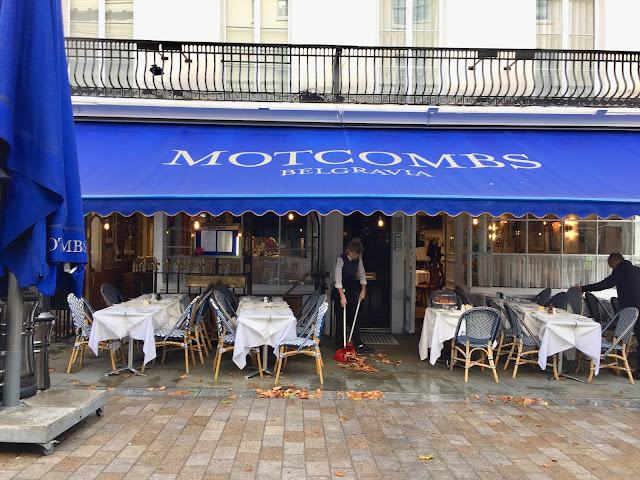





































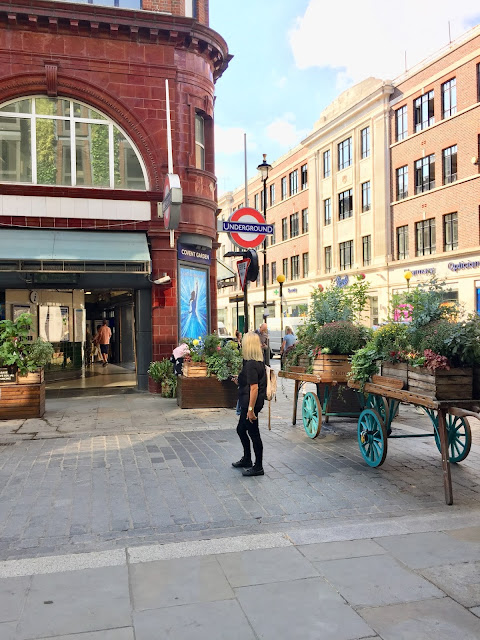






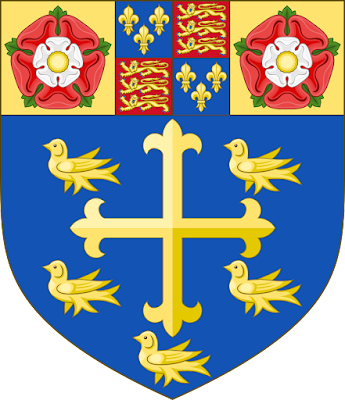
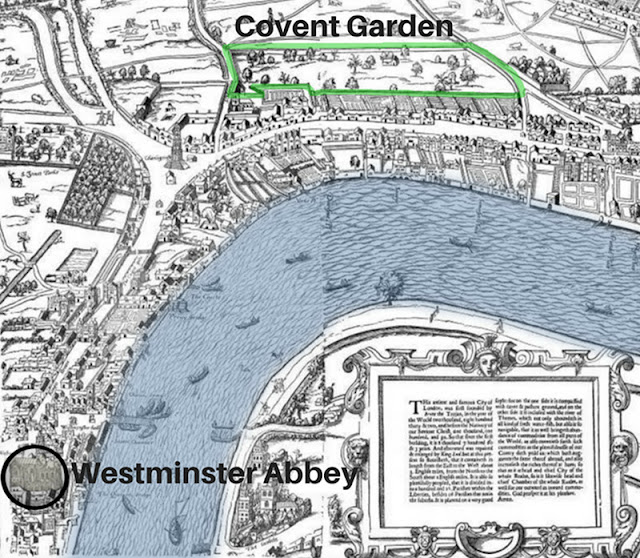













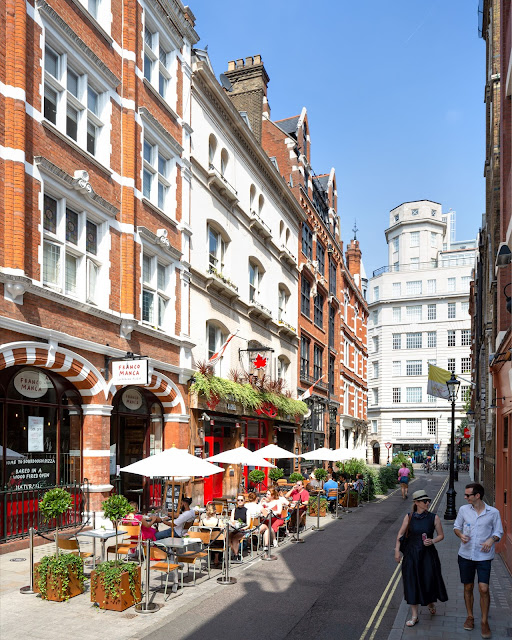





























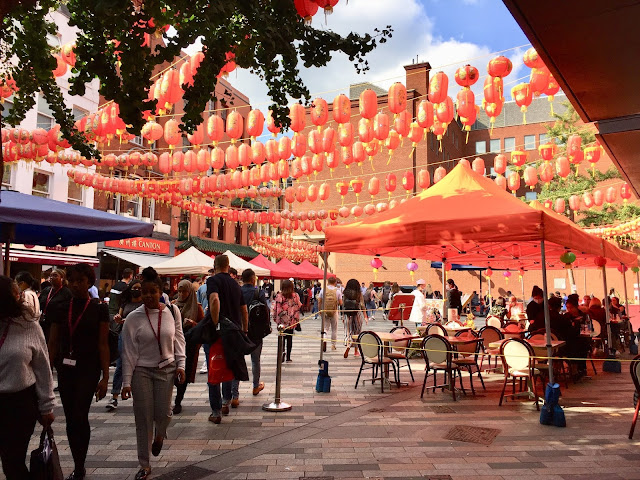






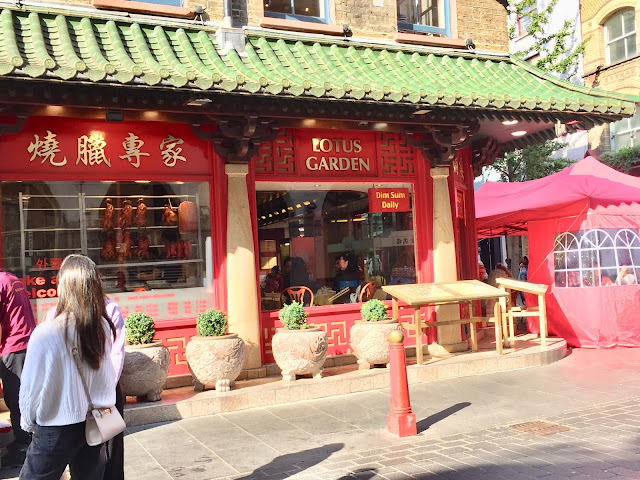



















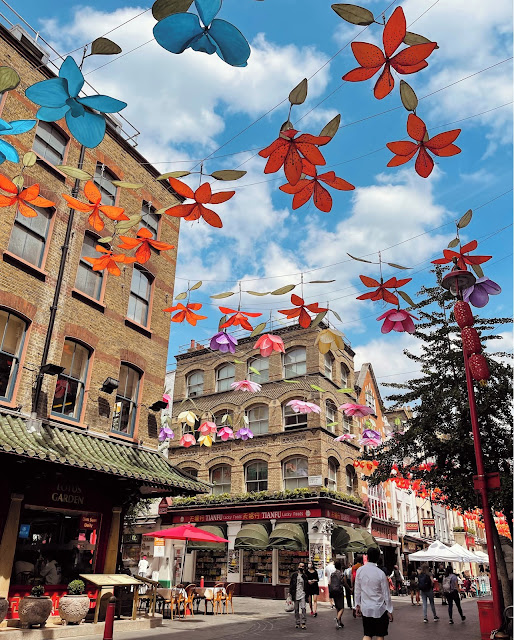










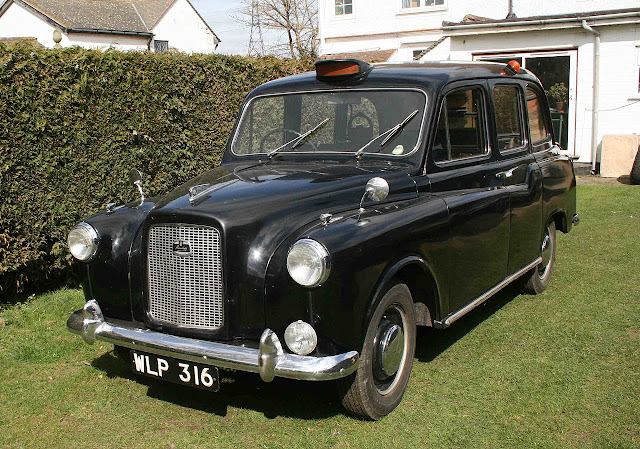








































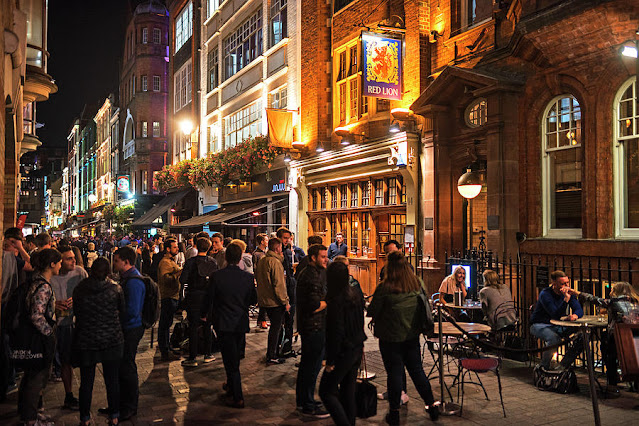





.jpg)



.jpg)




No comments:
Post a Comment
Don't be shy: leave your comments :)